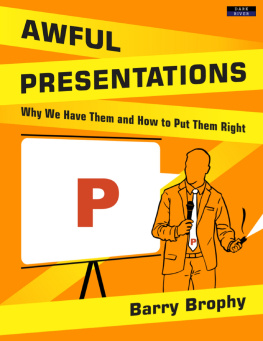Speaking Up
Surviving Executive Presentations
Speaking Up
Surviving Executive Presentations
Frederick Gilbert

Speaking Up
Copyright 2013 by Frederick Gilbert
All rights reserved. No part of this publication may be reproduced, distributed, or transmitted in any form or by any means, including photocopying, recording, or other electronic or mechanical methods, without the prior written permission of the publisher, except in the case of brief quotations embodied in critical reviews and certain other noncommercial uses permitted by copyright law. For permission requests, write to the publisher, addressed Attention: Permissions Coordinator, at the address below.

| Berrett-Koehler Publishers, Inc.
235 Montgomery Street, Suite 650
San Francisco, California 94104-2916
Tel: (415) 288-0260, Fax: (415) 362-2512
www.bkconnection.com |
Ordering information for print editions
Quantity sales. Special discounts are available on quantity purchases by corporations, associations, and others. For details, contact the Special Sales Department at the Berrett-Koehler address above.
Individual sales. Berrett-Koehler publications are available through most bookstores. They can also be ordered directly from Berrett-Koehler: Tel: (800) 929-2929; Fax: (802) 864-7626; www.bkconnection.com
Orders for college textbook/course adoption use. Please contact Berrett-Koehler: Tel: (800) 929-2929; Fax: (802) 864-7626.
Orders by U.S. trade bookstores and wholesalers. Please contact Ingram Publisher Services, Tel: (800) 509-4887; Fax: (800) 838-1149; E-mail: customer.service@ingrampublisherservices.com; or visit www.ingrampublisherservices.com /Ordering for details about electronic ordering.
Berrett-Koehler and the BK logo are registered trademarks of Berrett-Koehler Publishers, Inc.
First Edition
Paperback print edition ISBN 978-1-60994-896-2
PDF e-book ISBN 978-1-60994-901-3
IDPF e-book ISBN 978-1-60994-902-0
2013-1
Cover design: Nicole Hayward
For Mary McGlynn whose belief in this project and in me has made it all possible.
FIGURES
TABLES
Foreword
Over the course of my career, I have spent more than my fair share of time with other executives as we listened to woefully unprepared speakers drive staff productivity in the wrong direction. These speakers surely wanted to help our productivity, competitiveness, and bottom linebut they didnt. Senior management appreciates speakers who immediately get to the point with well-vetted information delivered in a concise manner. Failing that wastes time, and time is our most precious resource.
Between the covers of this book, you have actionable solutions to this problem. If you are an executive, sell these ideas in your organization. Meetings will become more productive. If you are in middle management, this book will help you succeed in those high-stakes, high-stress meetings where so much hangs in the balance, not the least of which may be your career.
I believe that leaders are born not made. The challenge of senior people is to identify those leaders rather than trying to create them.
In identifying future leaders, I look at how people communicate as one indicator of their leadership skill set. The ones that have those communication skills baked in have these three ingredients as part of their management DNA:
ContentThey are able to get to the point immediately, knowing the value of time in a roomful of executive decision makers.
Visual AidsThey understand that PowerPoint slides are not the focal point of the meeting. They know we want a discussion about an important topic, not a monologue and slide show.
ImprovisationThey are flexible by nature. When business reality demands that they be light on their feet, they improvise and create something new in a heartbeat.
In addition to these three communication skills, people who rise to the top levels at places like Sun Microsystems are able to manage a room full of bright, competitive, time-pressured executives with ease. Somehow, when things get off track or conflicts erupt, they know how to refocus the group and get us to a decision.
They understand that senior leadership wrestles with much bigger issues than just their department demands. Almost as second nature, they listen to the conflicts and issues around the table and summarize what they hear, creating a sense of trust. That trust tells me these are natural leaders.
Through his interviews with top-level executives from a wide variety of companies, Rick Gilbert has shined a light on the nature of these skills. This remarkable book breaks these highly sophisticated communication skills into learnable units. With the amazing insights of both the executives and the midlevel managers profiled in the book, you will learn how to present at top-level meetings. The executives will see you as a natural leader.
This book would have been useful for many of the people who presented to me over my career, but of course, it had not been written yet. Now it has been. You can cut years off your leadership learning curve by applying these skills.
Scott McNealy
Founder and former CEO of Sun Microsystems
Chairman of Wayin
Preface
For middle management, our quarterly board meetings are terrifying events. Every three months this hallway is lined with people in black suits with their presentations clutched in their hands and panic in their eyes, said our tour guide at the Atlanta, Georgia world headquarters of the Coca-Cola Company. She added, The tension is so high, I stay away from here on those days.
If you are in middle management, you live with daily ambiguity, lack of control, and even chaos. To get anything done, you must present your ideas to people up the chain, and those presentations can be brutal. Careers and projects can come unwound in a matter of minutes if the presenter doesnt know the rules at the top level. Your people depend on you being successful so that you will bring home the bacon. Although you may be confident speaking at your own level, as you go up the organization, your confidence can crumble knowing that the stakes are higher, and at the same time, the rules are very different from day-to-day presentations. What are these rules? That is what this book is about.
The good news is, the rules are simple and easy to learn: 1) know the people; 2) get to the point; and 3) improvise. Unfortunately a staggeringly high number of mid-level people (67%, actually) march right into top-level meetings and shoot themselves in the foot by: 1) not saying what they want at the beginning; 2) having too many PowerPoint slides; and 3) rigidly sticking to their scripts. This is a formula for career suicide.
Weve researched this topic for the past ten years, interviewing C-level executives, and getting input from literally hundreds of mid-level managers. The strategies you will learn in this book come directly from the executives who tell you exactly what to do to be successful in those high stakes meetings. In addition, this material has been road tested in hundreds of classes. We get feedback constantly from graduates who tell us stories of deals won and careers enhanced when they applied the principles you are about to learn.
Next page
















